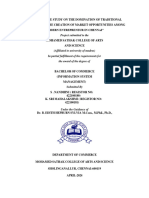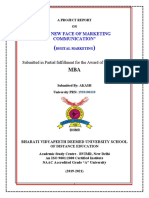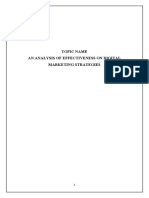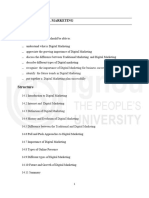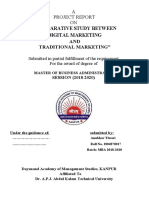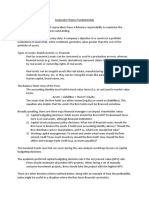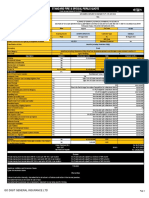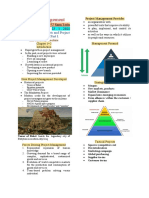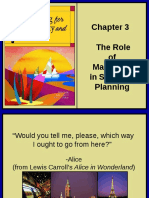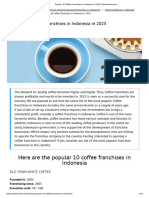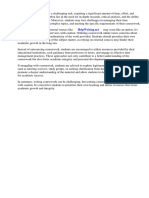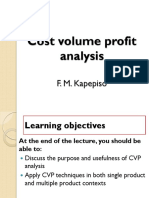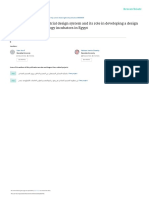PROJECT REPORT
" To Study The Transformation And Evolution
From Traditional
To Digital Marketing "
Submitted to
MBPG COLLEGE, HALDWANI
In partial fulfilment for the award of the
degree of
Master of commerce
Submitted by
Krishankant Arya
Under the Guidance of
Dr. Neeraj Tiwari
1
� CERTIFICATE
This is to certify that “KRISHANKANT ARYA” has submitted the project
report titled “ To Study The Transformation And Evolution From
Traditional To Digital Marketing’’, towards partial fulfilment of
MASTER OF COMMERECE degree examination. This has not been
submitted for any other examination and does not form part of any
other course undergone by the candidate.
It is further certified that he has ingeniously completed his project as
prescribed by Kumaun University, Nainital.
Dr. Neeraj Tiwari
(PROJECT GUIDE )
2
� DECLARATION
I here-by declare that the project with title “To Study The
Transformation And Evolution From Traditional To Digital Marketing’’
has been completed by me in partial fulfilment of MASTERS OF
COMMERECE degree examination as prescribed by Kumaun
University, Nainital and this has not been submitted for any other
examination and does not form the part of any other course
undertaken by me.
3
� ACKNOWLEDGEMENT
With immense pride and sense of gratitude, I take this golden
opportunity to express my sincere regards to DR. N.S. Bankoti,
Principal, MBPG, Haldwani
I am extremely thankful to my Project Guide Dr. Neeraj Tiwari for his
guideline throughout the project. I tender my sincere regards to Co-
Ordinator, for giving me outstanding guidance, enthusiastic
suggestions and invaluable encouragement which helped me in the
completion of the project.
I will fail in my duty if I do not thank the non-Teaching staff of the
college for their Co-operation. I would like to thank all those who
helped me in making this project complete and successful.
KRISHANKANT ARYA
4
� INDEX
SR. No PARTICULARS PAGE No.
1. Introduction 6-15
2. Literature 16-18
Review
3. Objectives of 19-20
Study
4. Scope of Study 21-22
5. Research 23-24
Methodology
6. Data Analysis & 25-27
Interpretation
7. Suggestions 28-29
8. Conclusion 30-31
9. Bibliography 32-33
5
�INTRODUCTION
6
�INTRODUCTION
In the past century, companies have made a great effort to
leave their rivals behind throughout the process of globalization and branding.
Companies follow various strategies in order to adopt to the competition and
make a difference. Additionally, meeting and satisfying customer needs have
become much more difficult since customer demands have increased. Moreover,
since the beginning of the 21st century, technology have been improving
drastically, causing changes in each and every part of our lives. Companies have
inevitably been affected by these changes and have started to use information
and communication technologies more and more in the market.
In the past century, companies have made a great effort to leave
their rivals behind throughout the process of globalization and branding.
Companies follow various strategies in order to adopt to the competition and
make a difference. Additionally, meeting and satisfying customer needs have
become much more difficult since customer demands have increased. Moreover,
since the beginning of the 21st century, technology have been improving
drastically, causing changes in each and every part of our lives. Companies have
inevitably been affected by these changes and have started to use information
and communication technologies more and more in the market.
WHAT IS MARKETING?
Marketing refers to any actions a company takes to attract an audience to the
company's product or services through high-quality messaging. Marketing aims
to deliver standalone value for prospects and consumers through content, with
the long-term goal of demonstrating product value, strengthening brand loyalty,
and ultimately increasing sales.
WHAT IS TRADITIONAL MARKETING?
Traditional marketing refers to any form of advertising or promotional activity
that has been used before the rise of digital media. This can include a wide range
of activities, such as print advertising (e.g. newspapers, magazines), broadcast
advertising (e.g. television, radio), direct mail marketing, telemarketing,
billboards, and in-person events and activations.
7
�WHAT IS DIGITTAL MARKETING?
Digital marketing (also known as data-driven marketing) is an umbrella term for
the marketing of products or services using digital technologies, mainly on the
Internet, but also including mobile phones, display advertising, and any other
digital medium. Digital marketing's development since the 1990s and 2000s has
changed the way brands and businesses utilize technology for marketing. As
digital platforms are increasingly incorporated into marketing plans and
everyday life, and as people use digital devices instead of visiting physical shops,
digital marketing campaigns are becoming more prevalent and efficient.
TRADITIONAL MARKETING
Techniques of Traditional Marketing:-
Direct Mail
Direct-mail marketing creates awareness of a product through postcards,
brochures, letters and fliers sent through mail. Direct mail is called a targeted
type of marketing strategy because information is sent to a specific target
market. However, direct-mail marketing can be expensive as a business incurs
design and printing costs as well as postage expenses to reach its target.
Print
8
�Print marketing includes advertising products and services through newspapers
and magazines. Print marketing is both a mass-marketing and niche-marketing
strategy. As a mass-marketing strategy, printed advertisements reach different
classes of people, who might or might not have an interest in the product. In
magazines, print marketing reaches out to the niche market that reads the
magazine, such as women, fathers, teens or car lovers.
Broadcast
Television and radio are traditional avenues still widely used. Broadcast
marketing reaches a large audience within a limited period of time. Television
advertisements also bring authenticity and realism to a product as people can
see how the product works. However, broadcast messages have a shorter
lifespan compared with printed messages.
Referral
Referral marketing, also known as word of mouth, relies on customers to spread
information about products or services. Referral is not a strategic or planned
marketing activity, but it might help a business build a loyal client base. It also
costs close to nothing for the business.
Billboards
Billboards are some of the largest forms of traditional advertising. Many exist on
the interstate to entice travelers to stop along their journeys. These
advertisements must be short and very visible to have an impact. It is also
important for the billboards to be placed in an area that receives a lot of traffic,
as well as in a reasonable proximity to the business.
9
�Newspapers
Newspapers are one of the oldest areas in which to place advertisements. With
new editions daily, in most cases, this makes it also the most disposable type of
advertising. The effect must be gathered before the consumer turns the page or
the usefulness of the advertisement is gone forever. Most newspapers have a
readership that consists mostly of local people to your area. however, there are
a few national newspapers. Consider your target market and which newspaper
they are most likely to read prior to purchasing newspaper advertisements.
Advantages and Disadvantages of Traditional Marketing
Advantages:-
• Reach
You can reach a group of specific consumers that do not necessarily
utilize internet browsing.
• Face to Face Contact
Personalized marketing is considered to be one of the best strategies and
the most efficient method to gain recognition as a brand and product.
• Tangible Offers
Traditional Marketing offers tangibility- this refers to ads or products that
clients contact in during their free time, like a newspaper ad for example.
Disadvantages:-
• Expensive
10
� Purchasing television, radio, or printed ads tends to be pricey for both
small and mid-sized businesses.
• Inefficiency
Unlike Online Marketing, it is quite difficult to measure the conversion
rate of your ads through traditional marketing, which makes it difficult to
have a good understanding of the efficiency of your ads and the results
they offer.
DIGITAL MARKETING
Digital Marketing Tactics:-
• Content Marketing
Content marketing is a strategic marketing approach focused on creating
and distributing valuable, relevant, and consistent content to attract and
retain a clearly defined audience and, ultimately, to drive profitable
customer action.
• Display Advertising
Based on your audience profile and your products, select ad space in
specific websites from where you can get good traffic. Display ads can be
anything from the banner ads to videos. In the online world, it is
considered as one of the most effective ways of digital branding. Instead
of developing text-based communication, create interesting videos or
images that will speak on behalf of your brand. Also, take time to follow
your targets and wisely choose the websites, which in turn are followed
by your audience group.
11
�• Mobile Marketing
Mobile-centric ads are the current trend. From the in-app messages to
the videos, mobile advertising is the most effective way to promote your
brand. With the entire world going mobile, developing short and crisp
communication targeting the mobile users is the best practice. As people
carry their mobiles your brand communication stays in their mind, for a
longer time. While developing mobile ads, ensure that it fits the screen
sizes of all hand-held devices. In this way, your message will be clear and
you shall successfully position your brand name in the minds of your
targets.
• Marketing Skills
Digital marketers support the wider marketing team and the strategic
goals of the whole company by rolling out marketing strategies in the
online environment, Hobson said. Digital marketers strive to be a voice
for the customer and how they want to interact with a brand digitally,
Rogers said.
• Email Marketing
12
� Even with the emergence of social media, mobile applications and other
channels, email is still one of the most effective marketing techniques,
Rogers said. It can be part of a content marketing strategy, providing
value to consumers and over time convert an audience into customers.
• Affiliate Marketing
With the increased prominence of online marketing, affiliate
marketing—also known as influencer marketing has become popular
among many organizations in bridging the gap between consumers and
organizations.
Advantages of digital marketing;-
1. Global reach - a website allows you to find new markets and trade
globally for only a small investment.
2. Lower cost - a properly planned and well targeted digital marketing
campaign can reach the right customers at a much lower cost than
traditional marketing methods.
3. Trackable, measurable results - measuring your online marketing with
web analytics and other online metric tools makes it easier to establish
how effective your campaign has been. You can obtain detailed
information about how customers use your website or respond to your
advertising.
Disadvantages of digital marketing:-
1. Skills and training - You will need to ensure that your staff have the right
knowledge and expertise to carry out digital marketing with success.
13
� Tools, platforms and trends change rapidly and it's vital that you keep up-
to-date.
2. Time consuming - Tasks such as optimizing online advertising campaigns
and creating marketing content can take up a lot of time. It's important
to measure your results to ensure a return-on-investment.
3. High competition - While you can reach a global audience with digital
marketing, you are also up against global competition. It can be a
challenge to stand out against competitors and to grab attention among
the many messages aimed at consumers online.
THE 4 PS OF MARKETING AND THEIR IMPLICATIONS FOR DIGITAL MARKETING
• Product
This may be a physical product or a service proposition. The key here is that
something is developed that people actually want to buy. Some businesses
begin with a product and then try to force that on an audience. If there is no
demand for your product and no one is interested then you will not be able to
create demand.
• Price
Pricing is the second P and one that can be more of a science than an art.
Understanding price elasticity and competitive positioning are angles to
consider but the key factor is whether the price reflects the amount that
people are willing to pay. The ‘willing to pay’ element depends on many factors
such as brand value, online reviews, product quality and others but there are
also numerous pricing tactics and strategies that can be employed during the
different phases of the product life cycle.
• Place
Location, location, location. In the marketing mix, the process of moving
products from the producer to the intended user is called place. In other
words, it is how your product is bought and where it is bought. This movement
could be through a combination of intermediaries such as distributors,
wholesalers and retailers. Building your shop in the wrong place decreases
footfall and ultimately means fewer sales. Having your shop in the right place
but not having the stock in the shop is even worse.
14
�• Promotion
Promotion is what most people think of when they hear the word marketing
and consists of TV campaign, press advertising and display banners. This is
often the first time that people will have any relationship with the company’s
brand and in below-the-line marketing; this can be a personal relationship. To
be successful in digital marketing, first impressions about the company are very
important and hence so getting the company’s promotion strategy right is vital
15
�LITERATURE
REVIEW
16
�LITERATURE REVIEW
According to Neelika Arora Has published research article entitled "Trends in
Online Advertising" in advertising Express, Dec 2013. The global online
advertising revenues are expected to touch US $10bn by 2015. In India, the
revenues at present are estimated to be Rs 80 cr. and are expected to increase
six times more within the next five years. In India, Internet as a medium is
accepted by a wider industrial segment that includes automobiles, telecom,
education, banking, insurance, credit cards. FMCG (Fast Moving Consumer
Goods), apparel clothing, durables, media, business services and tourism. Out
of these, it is estimated that the banking, FMCG and insurance sectors together
account for 45% of the total advertising spend. Some of the top spenders in
India are automobiles, followed by brands like Pepsodent, Kelloggs, Cadbury,
HDFC(Housing Development Finance Corporation Ltd.) loans and Sunsilk. In
addition to these the early adopters in the field of finance and IT are also
increasing their spending.
According to Sumanjeet Has published article on "On Line Banner Advertising"
in Indian Journal of Marketing Online banner advertising has great potential as
an advertising medium. It is easy to create, place and use. It offers companies
targeting well educated. Innovative, affluent males/females or students with
great potential for success as their segments are highly represented
According to Vikas Bondar He has published his article on "sales and marketing
strategies" Internet is a really good thing. The Internet gives people a greater
amount of information as we need. It is the best way to get a comparison of
the products that we need. If we are interested in buying. it is best for us to
check the Web sites. Also if we would like to make our own Web page we can
do this, without paying a lot of money. From where do we set all this
information? The answer is from advertising, which we see. everywhere on TV
on the Internet, in the newspapers and more. Year after year we get more and
more new, interesting information and in the future the Internet use will
17
�increase more than now. This article explains how internet is useful tool for
advertisement.
According to Garder's survey The top priority in digital marketing investment
will be to improve commerce experiences through social marketing, content
creation and management and mobile marketing. Key findings also revealed
that a company' marketing success relies mostly on their website, social
marketing, and digital advertising, which are all parts of digital marketing. In
addition, savings made by using digital marketing can be reinvested elsewhere.
Normally, companies spend 10 percent of their revenue on marketing and 2.4
percent on digital marketing, which will increase to 9 percent in the future.
According to Taylor He had predict that by 2020 that all traditional outdoor
advertising space in major cities will be replaced by digital displays. It is worth
nothing that a lot of DOOH (traditional and non-traditional media interlink) can
be used in tandem with programmatic, to create an immersive experience that
changes based on real time variables.
18
�OBJECTIVES OF
STUDY
19
�OBJECTIVES OF STUDY
• To study the effect of Digital marketing on brand awareness and overall
perception of the company.
• To know whether online marketing is better than offline marketing in today’s
scenario.
• To gather knowledge about the various modes of marketing.
• To evaluate the mode of marketing gives better results in terms of sale, profit
etc.
• To identify the satisfaction level of customers about online and traditional
marketing.
20
�SCOPE OF STUDY
21
�SCOPE OF STUDY
• Conducting market research to identify the target audience and their
digital behaviours and preferences.
• Evaluating and optimizing email marketing campaigns to improve open
rates, clickthrough rates, and conversion rates.
• Analyzing website traffic and user behaviour through web analytics tools
to identify areas for improvement.
• Developing a content marketing strategy that aligns with the brand's
messaging and business objectives.
• Creating and executing a social media marketing campaign to increase
brand awareness and engagement.
22
� RESEARCH
METHODOLOGY
23
�RESEARCH METHODOLOGY
Steps or techniques used to identify, select, process, and analyze information
so as to clearly understanding the research problem with the help of data or
information. In this study both primary and secondary data has been used for
carrying out the result.
MODE OF DATA COLLECTION:
There are two types of data:
• Primary Data: Primary research is data which is obtained firsthand. This
means that the researcher conducts the research. Primary research
means going directly to the source, rather than relying on pre-existing
data samples.
• Secondary Data: Secondary research is also known as desk research.
This type of research relies on pre-existing data sources such as company
websites, articles and market research reports. It is generally carried out
at a desk, either offline (via books, research documents, etc.) or online
(via websites, pdf reports, etc.).
This study is based on secondary data which collected using different websites
available on the internet. We also collected data from various websites
available on the internet including the official website of the company and
other survey conducting websites
24
�DATA ANALYSIS &
INTERPRETATION
25
�DATA ANALYSIS & INTERPRETATION
• Showing which method of marketing you prefer
Particulars No. of respondents Percentage
Online marketing 32 64
Traditional Marketing 18 36
Total 50 100
• Showing which method of marketing mostly preferred by people
Series 1
70
60
50
40
30
20
10
0
Traditional Marketing Digital Marketing
• Showing what are the benefits does traditional marketing offer over the
online marketing
26
� Particulars No. of respondents Percentage
Wide range of 5 10
information
Low cost 6 12
Time saving 13 26
Ease of shopping 19 38
Interactive medium 7 14
Total 50 100
• Showing the benefits does traditional marketing offer over the online
marketing
Benefits
40
35
30
25
20
15
10
0
Wide range of Lowcost Time saving Ease of shopping Interactive medium
information
Benefits
Interpretation
It shows the benefits does traditional marketing offer over the online
marketing. 58% of respondents opinion that traditional marketing offer easy of
shopping over than online marketing, 26% of respondents opinion that time
saving is provided by traditional marketing, 14% of respondents opinion that
traditional marketing as a interactive medium and 12% respondents opinion
that traditional marketing offer low cost.10% of respondents opinion that
traditional marketing offer wide range of information.
27
�SUGGESTIONS
28
�SUGGESTION
• Know your audience: Understanding your target audience is essential for
creating effective digital marketing campaigns. Research your audience's
demographics, interests, and behaviours to tailor your messaging and
targeting.
• Use social media effectively: Social media platforms are an essential part
of any digital marketing strategy. Identify the platforms your audience
uses most and create a presence there. Engage with your followers,
share valuable content, and use social media advertising to reach new
audiences.
• Optimize for mobile: With more than half of all web traffic coming from
mobile devices, it's essential to optimize your website and marketing
campaigns for mobile. Make sure your website is mobile-friendly and
create mobile-specific content and ads.
• Leverage SEO: Search engine optimization (SEO) is a powerful tool for
driving organic traffic to your website. Use keyword research to optimize
your website's content and structure, and focus on creating valuable and
relevant content that will rank well in search engines.
• Use data to inform your strategy: Digital marketing generates a wealth of
data, from website analytics to social media engagement metrics. Use
this data to track the performance of your campaigns and make data-
driven decisions about where to invest your marketing resources.
• Stay up to date with the latest trends: Digital marketing is a fast-paced
and constantly evolving field. Stay up to date with the latest trends and
technologies, such as AI, voice search, and personalization, to stay ahead
of the competition.
29
�CONCLUSION
30
�CONCLUSION
In conclusion, the transformation from traditional to digital marketing has
brought about a wealth of data that can help businesses evaluate the success
of their campaigns. By analyzing website traffic, social media engagement,
conversion rates, cost per acquisition, and customer lifetime value, businesses
can gain a deeper understanding of their marketing efforts and make data-
driven decisions.
The transformation from traditional to digital marketing has been significant in
the last few years. By incorporating digital platforms, businesses can now reach
a much larger audience quickly and efficiently. The availability of data analytics
and tracking tools helps businesses to understand and evaluate the
performance of their marketing campaigns in real-time. This ensures that they
can optimize their approach, deliver targeted messages, build customer
relationships efficiently and drive engagement for better results. The digital
marketing revolution has transformed the way companies do business,
providing many new opportunities for growth and profitability. As a result,
businesses that are embracing digital marketing strategies are growing and
becoming more successful today.
Overall, digital marketing is a dynamic and challenging field that requires
businesses to stay up to date with the latest trends and technologies. By
implementing effective digital marketing strategies and leveraging the power of
31
�AI, businesses can gain a competitive advantage and achieve long-term
success.
BIBLIOGRAPHY
32
�BIBLIOGRAPHY
LINKS:-
• https://www.mygreatlearning.com/blog/introduction-to-digital-marketing/
• https://www.simplilearn.com/traditional-marketing-vs-digital-marketing-
article
• https://www.simplilearn.com/history-and-evolution-of-digital-marketing-
article
• https://www.perceptive.co.nz/blog/from-traditional-to-digital-the-evolution-
of-digital-marketing-strategy
• https://www.journalbusinesses.com/index.php/revista/article/view/295/661
33
�•https://www.researchgate.net/publication/303163963_Digital_Marketing_in_I
ndian_Context
• https://www.customermonitor.com/blog/from-traditional-to-digital-the-
evolution-of-digital-marketing-strategy
• https://www.studocu.com/in/document/itm-group-of-
institutions/management-of-new-ventures/299399529-finalproject-report-on-
digital-marketing/16260347
REFERENCE
Digital Transformation |Digital Transformation: Survive and Thrive in an Era of
Mass Extinction - Thomas M. Siebel - Google Books
Principles of Marketing | basic concepts of marketing | By Pearson by Neelika
Arora (Author), Gary Armstrong (Author), Prafulla Agnihotri (Author)
Paperback : https://amzn.to/3AyKn9P
Marketing Management |marketing cases in the Indian context | Fifteenth
Edition | By Pearson by Avinash kaushik (Author), Keven Lane Keller (Author),
Others (Author)
Paperback : https://amzn.to/3IGDJkt
34








